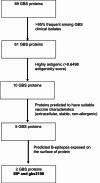Surface protein distribution in Group B Streptococcus isolates from South Africa and identifying vaccine targets through in silico analysis
- PMID: 39349584
- PMCID: PMC11442663
- DOI: 10.1038/s41598-024-73175-4
Surface protein distribution in Group B Streptococcus isolates from South Africa and identifying vaccine targets through in silico analysis
Abstract
Group B Streptococcus (GBS) is a major cause of pneumonia, sepsis, and meningitis in infants younger than 3 months of age. Furthermore, GBS infection in pregnant women is associated with stillbirths and pre-term delivery. It also causes disease in immunocompromised adults and the elderly, but the highest incidence of the disease occurs in neonates and young infants. At this time, there are no licensed vaccines against GBS. Complete GBS genome sequencing has helped identify genetically conserved and immunogenic proteins, which could serve as vaccine immunogens. In this study, in silico reverse vaccinology method were used to evaluate the prevalence and conservation of GBS proteins in invasive and colonizing isolates from South African infants and women, respectively. Furthermore, this study aimed to predict potential GBS vaccine targets by evaluating metrics such as antigenicity, physico-chemical properties, subcellular localization, secondary and tertiary structures, and epitope prediction and conservation. A total of 648 invasive and 603 colonizing GBS isolate sequences were screened against a panel of 89 candidate GBS proteins. Ten of the 89 proteins were highly genetically conserved in invasive and colonizing GBS isolates, nine of which were computationally inferred proteins (gbs2106, SAN_1577, SAN_0356, SAN_1808, SAN_1685, SAN_0413, SAN_0990, SAN_1040, SAN_0226) and one was the surface Immunogenic Protein (SIP). Additionally, the nine proteins were predicted to be more antigenic than the SIP protein (antigenicity score of > 0.6498), highlighting their potential as GBS vaccine antigen targets.
Keywords: Group B streptococcus; In silico; Maternal vaccination; Prevalence; Vaccine development.
© 2024. The Author(s).
Conflict of interest statement
The authors declare no competing interests.
Figures




References
-
- Edmond, K. M. et al. Group B streptococcal disease in infants aged younger than 3 months: systematic review and meta-analysis. Lancet379, 547–556 (2012). - PubMed
-
- Mynarek, M. et al. Mortality and neurodevelopmental outcome after invasive group B streptococcal infection in infants. Dev. Med. Child Neurol10.1111/dmcn.15643 (2023). - PubMed
MeSH terms
Substances
LinkOut - more resources
Full Text Sources
Medical
Miscellaneous

